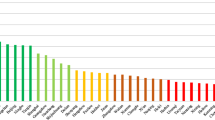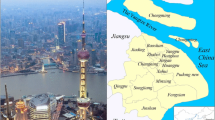Abstract
Urban agglomerations in China have become the strategic core of national economic development and the main component of the new type of urbanization. However, they are threatened by a series of eco-environmental problems and challenges, including the severe overexploitation of natural resources. Eco-efficiency, which is defined as accomplishing the greatest possible economic benefit with the least possible resource input and damage to the environment, is used as an indicator to quantify the sustainability of urban agglomerations. In this work, a traditional data envelopment analysis (DEA) model with a slack-based measurement (SBM) model of undesirable outputs, was used to assess and compare the economic efficiency and eco-efficiency of four major urban agglomerations in eastern China (UAECs) in 2005, 2011, and 2014. The spatio-temporal characteristics of the evolution of urban agglomerations were analyzed. Based on the results of a slack analysis, suggestions for improving the eco-efficiency of the four UAECs are provided. The overall economic efficiency of urban agglomerations located in the Shandong Peninsula, Yangtze River Delta, and Pearl River Delta displayed a V-shaped pattern (decreased and then increased). In contrast, the overall economic efficiency of the Beijing-Tianjin-Hebei urban agglomeration declined during the study period. The Beijing-Tianjin-Hebei urban agglomeration had a considerable loss of economic efficiency due to pollution, whereas the Shandong Peninsula urban agglomeration was less impacted. Overall, the eco-environmental efficiency of the four UAECs declined from 2005 to 2011 and then increased from 2011 to 2014. In addition, the urban eco-efficiency in the four coastal UAECs was characterized by different evolution patterns. The eco-efficiency was higher in the peri-urban areas of the core cities, riverside areas, and seaside areas and lower in the inland cities. The core cities of the Beijing-Tianjin-Hebei, Yangtze River Delta, and Pearl River Delta urban agglomerations were characterized by high resource consumption, economic benefit output, and eco-efficiency. In most of cities in the urban agglomerations, the emission of pollutants declined, leading to a reduction of pollutants and mitigation of environmental problems. In addition, a differential analysis, from the perspective of urban agglomeration, was performed, and concrete suggestions for improvement are proposed.
Similar content being viewed by others
References
Bai Y P, Deng X Z, Jiang S J et al., 2018. Exploring the relationship between urbanization and urban eco-efficiency: Evidence from prefecture-level cities in China. Journal of Cleaner Production, 195: 1487–1496.
Bozoglu M, Ceyhan V, 2009. Energy conversion efficiency of trout and sea bass production in the Black Sea, Turkey. Energy, 34(2): 199–204.
Camarero M, Castillo J, Picazo-Tadeo A J el al., 2013. Eco-efficiency and convergence in OECD countries. Environmental and Resource Economics, 55(1): 87–106.
Charnes A, Cooper W W, Golany B el al., 1985. Foundations of data envelopment analysis for Pareto-Koopmans efficient empirical production functions. Journal of Economelrics, 30(1/2): 91–107.
Cooper W W, Seiford L M, Tone K, 2007. Data Envelopment Analysis: A Comprehensive Text with Models, Applications, References, and DEA-solver Software. Springer.
Cooper W W, Seiford L M, Zhu J, 2011. Data Envelopment Analysis: History, Models, and Interpretations. Springer.
EEA, 1999. Making Sustainability Accountable: Eco-Efficiency, Resource Productivity and Innovation. European Environment Agency Publication.
EEA, 2000. Environmental Signals, Copenhagen. European Environment Agency Publication.
Fang C L, 2014. Important research progress and development directions of China’s urban agglomeration. Acla Geographica Sinica, 69(8): 1130–1144. (in Chinese)
Fang C L, Guan X L, 2011. Comprehensive measurement and spatial distinction of input-output efficiency of urban agglomerations in China. Acla Geographica Sinica, 66(8): 1011–1022. (in Chinese)
Fang C L, Mao Q Z, Ni P F, 2015. Discussion on the scientific selection and development of China’s urban agglomerations. Acla Geographica Sinica, 70(4): 515–527. (in Chinese)
Fang C L, Song J T, Zhang Q el al., 2005. The formation, development and spatial heterogeneity patterns for the structures system of urban agglomerations in China. Acla Geographica Sinica, 60(5): 827–840. (in Chinese)
Fang C L, Yu D L, 2017. Urban agglomeration: An evolving concept of an emerging phenomenon. Landscape & Urban Planning, 162: 126–136.
Goto M, Otsuka A, Sueyoshi T, 2014. DEA (Data Envelopment Analysis) assessment of operational and environmental efficiencies on Japanese regional industries. Energy, 66: 535–549.
Huang Y, Li L, Yu Y T, 2018. Does urban cluster promote the increase of urban eco-efficiency? Evidence from Chinese cities. Journal of Cleaner Produclion, 197: 957–971.
Huppes G, Ishikawa M, 2005. A framework for quantified eco-efficiency analysis. Journal of Induslrial Ecology, 9(4): 25–41.
Lee T, Yeo G, Thai V, 2014. Environmental efficiency analysis of port cities: Slacks-based measure data envelopment analysis approach. Transport Policy, 33(4): 82–88.
Liu Yong, Wang W, Li X Q el al., 2010. Eco-efficiency of urban material metabolism: A case study in Xiamen, China. Inlernalional Journal of Suslainable Developmenl & World Ecology, 17(2): 142–148.
Lu B, Yang J X, 2006. Review of methodology and application of eco-efficiency. Acla Ecologica Sinica, 26(11): 3898–3906. (in Chinese)
Mao N, Song M J, Deng S M, 2016. Application of TOPSIS method in evaluating the effects of supply vane angle of a task/ambient air conditioning system on energy utilization and thermal comfort. Applied Energy, 180: 536–545.
Rashidi K, Shabani A, Saen R F, 2015. Using data envelopment analysis for estimating energy saving and undesirable output abatement: A case study in the Organization for Economic Co-operation and Development (OECD) countries. Journal of Cleaner Produclion, 105: 241–252.
Schaltegger S, Synnestvedt T, 2002. The link between ‘green’ and economic success: environmental management as the crucial trigger between environmental and economic performance. Journal of Environmenlal Managemenl, 65(4): 339–346.
Shabani A, Torabipour S M R, Farzipoor Saen R el al., 2015. Distinctive data envelopment analysis model for evaluating global environment performance. Applied Malhemalical Modelling, 39(15): 4385–4404.
UNESCAP, 2010. Eco-efficiency Indicators: Measuring Resource-use Efficiency and the Impact of Economic Activities on the Environment. United Nations Publication.
United Nations Conference on Trade and Development, 2003. Integrating Environmental and Financial Performance at the Enterprise Level: A Methodology for Standardizing Eco-efficiency Indicators. United Nations Publication, 29–30.
WBCSD, 2001. Eco-efficient Leadership for Improved Economic and Environmental Performance. World Business Council for Sustainable Publication.
Wettemann P J C, Latacz-Lohmann U, 2017. An efficiency-based concept to assess potential cost and greenhouse gas savings on German dairy farms. Agricullural Syslems, 152: 27–37.
Wu Q, Wu C Y, 2009. Research on evaluation model of energy efficiency based on DEA. Journal of Managemenl Sciences, 22(1): 103–112. (in Chinese)
Zhang B, Bi J, Fan Z Y el al., 2008. Eco-efficiency analysis of industrial system in China: A data envelopment analysis approach. Ecological Economics, 68(1/2): 306–316.
Zhang J R, Guo Y H, 2004. The relationship between the number of factors and DEA efficiency. Syslems Engineering: Theory Melhodology Applicalions, 13(6): 520–523. (in Chinese)
Zhou C S, Shi C Y, Wang S J el al., 2018. Estimation of eco-efficiency and its influencing factors in Guangdong province based on super-SBM and panel regression models. Ecological Indicalors, 86: 67–80.
Author information
Authors and Affiliations
Corresponding author
Additional information
Foundation: Major Program of National Natural Science Foundation of China, No. 41590840, No. 41590842; National Natural Science Foundation of China, No. 41371177
Author: Ren Yufei (1990-), specialized in sustainable development of urban agglomerations.
Rights and permissions
About this article
Cite this article
Ren, Y., Fang, C., Lin, X. et al. Evaluation of the eco-efficiency of four major urban agglomerations in coastal eastern China. J. Geogr. Sci. 29, 1315–1330 (2019). https://doi.org/10.1007/s11442-019-1661-7
Received:
Accepted:
Published:
Issue Date:
DOI: https://doi.org/10.1007/s11442-019-1661-7




